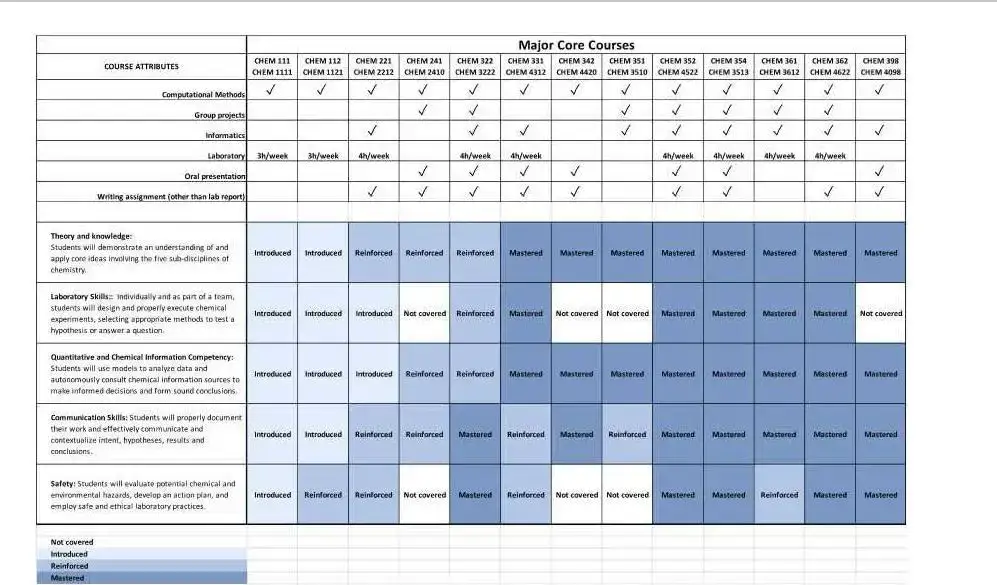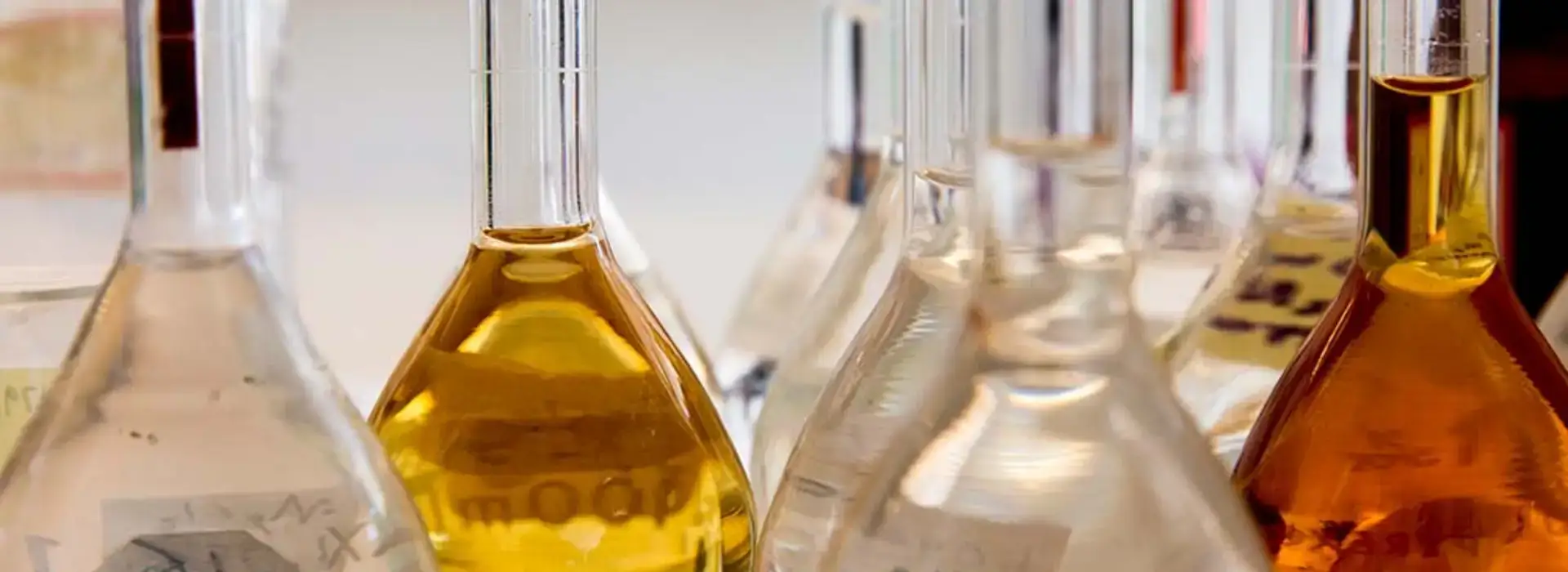Program Goal
Each student will demonstrate the ability to function as a working chemist and engage in scientific problem solving based on a comprehensive understanding of fundamental chemical concepts.
Student Learning Outcomes
Our learning outcomes are indirectly, but heavily influenced by our program approving body, the American Chemical Society Committee on Professional Development. The ACS requires us to provide a parallel review similar to this one. View the ACS guidelines.
Overview of Assessment Structures
Our department collects assessment data and summarizes it into reports yearly. Assessment plans are made/updated about every 3 years. At the start of this evaluation period, assessments were done with chemistry and biochemistry majors combined because the biochemistry major was new. However, starting in Fall 2018, the Biochemistry program was assessed separately.
Student learning outcomes (SLOs) organized around 5 key requirements for chemists were developed by our faculty. These outcomes have been mapped across our curriculum. The current curriculum map for the Chemistry program is shown below. From there, measures were chosen and faculty assigned to collect the data for each academic year. Each year, data is collected, interpreted, and an assessment summary is written. A sample assessment report for the 2017‐2018 academic year can be found in the appendix and is linked at the end of this section.
Curriculum Map for Chemistry Program: Core Courses (updated 2020)

What outcomes are we measuring?
The student learning outcomes that are assessed by our department are listed below for the chemistry and biochemistry major programs. Student learning outcomes (SLOs) organized around 5 key topic requirements for chemists and 6 for biochemists were developed by our faculty. We previously had 10 SLOs, but these have been distilled down to better allow us to decide upon a workable number of curricular changes.
Student Learning Outcomes for Chemistry and Biochemistry B.S. Majors
Chemistry B.S.
Theory and knowledge:
Students will demonstrate an understanding of and apply core ideas involving the five sub‐disciplines of chemistry.
Laboratory Skills:
Individually and as part of a team, students will design and properly execute chemical experiments, selecting appropriate methods to test a hypothesis or answer a question.
Quantitative and Chemical Information Competency:
Students will use models to analyze data and autonomously consult chemical information sources to make informed decisions and form sound conclusions.
Communication Skills:
Students will properly document their work and effectively communicate and contextualize intent, hypotheses, results and conclusions.
Safety:
Students will evaluate potential chemical and environmental hazards, develop an action plan, and employ safe and ethical laboratory practices.
Biochemistry B.S.
Theory and knowledge:
Students will demonstrate an understanding of and apply core ideas involving the five sub‐disciplines of chemistry.
Laboratory Skills:
Individually and as part of a team, students will design and properly execute chemical experiments, selecting appropriate methods to test a hypothesis or answer a question.
Quantitative and Chemical Information Competency:
Students will use models to analyze data and autonomously consult chemical information sources to make informed decisions and form sound conclusions.
Communication Skills:
Students will properly document their work and effectively communicate and contextualize intent, hypotheses, results and conclusions.
Safety:
Students will evaluate potential chemical and environmental hazards, develop an action plan, and employ safe and ethical laboratory practices.
Interdisciplinary understanding:
Students will integrate their knowledge of chemistry with key concepts in cellular and molecular biology.
What measures are used?
DUCK Exam
Generally speaking, our assessment plans in the past have relied heavily on the American Chemical Society (ACS) Examination Institutes’ Diagnostic Undergraduate Chemistry Knowledge exam (a.k.a. the DUCK exam). This is a nationally standardized exam and data allowing us to compare our cohorts to results of students across the United States. Use of an ACS exam is also appropriate since we are an ACS accredited program. We’ve used the 2008 version for multiple years, giving the exam during the final exam period of CHEM 398: Senior Seminar. All majors are required to take this class, ordinarily in the fall semester of their senior year. Because of our use of the DUCK the Department is evaluating its students’ learning primarily by comparing their demonstrated performance to that for institutions who self‐report their results to the ACS Examinations Institute.
Recent Shift
The department realized that use of DUCK was not ideal for some assessment questions. For example, it does not well assess students’ understanding or demonstration on laboratory skills. In specific terms of theory, the DUCK did not well assess understanding in inorganic chemistry because the exam is given in the fall semester of the senior year, but the senior‐level inorganic course is given the following spring. Because of these issues, our newest assessment plan (2020) takes a broader approach – still utilizing the DUCK where effective but also building in more course‐based assessments.
Safety Exam
For the safety outcomes, we have a Safety & Hygiene Exam that can be used at multiple levels of chemistry courses. The department jointly developed this exam covering basic laboratory safety as well as broader safety information graduates should be familiar with as they leave and enter the workforce.
Course Specific Exams and Assignments
Throughout our assessments, we have found that there are some SLOs which would be better assessed using course‐ level exams/assignments. Examples of course specific exams/assignments that we have used over the course of the evaluation period include:
| What Outcome (SLO) | Measure | Description | Course |
|---|---|---|---|
| 4 Communication Skills (Oral) | Senior presentations | These presentations are assessed by faculty using a rubric | Chem 398 Senior Seminar |
| 4 Communication Skills (Written) | Proposal for Museum Exhibit | Students write a paper outlining their proposal for creating a children’s museum exhibit that teaches one or more fundamental chemistry concepts. | Chem 398 Senior Seminar |
| 1 Theory: Organic Chemistry | Exam questions from final exam | Essential Questions = Do students understand chemical reactivity? We will use exam items that measure the following:
| Chem 221 Organic Chem I |
What kind of data is collected?
DUCK Exam
Since this is a nationally standardized exam, we can compare data to national norms provided by the ACS.
- Questions have been assigned to their appropriate outcome (SLO)
- The number of our students at each level (Exceeds, Meets, or Does Not Meet Expectations) were counted. Levels were determined by comparing to the national percentiles.
- Question results with the same outcome (SLO) are averaged.
Criteria: Levels for Test Items
| “Exceeds Expectations” for questions in the DUCK exam | More than 5% above relative percentage correctly answering a question compared to self‐reporting institutions. |
| “Meets Expectations” for questions in the DUCK exam | 25% below to 5% above (‐25% to 5%) relative percentage correctly answering a question compared to self‐reporting institutions. |
| “Does Not Meet Expectations” for questions in the DUCK exam | More than 25% below (less than ‐25%) relative percentage correctly answering a question compared to self‐reporting institutions. |
Relative percentage is compared to other reporting institutions. For example, if on a question other reporting institutions had reported 70% of their students answered correctly, our criteria would be:
- Does Not Meet Expectations (52% or less answering correctly)
- Meets Expectations (53% to 73% answering correctly)
- Exceeds Expectations (74% or greater answering correctly)
Example:
For each SLO, we look at how our students perform on a group of questions related to that SLO. If an SLO has 10 questions associated with it, and our students Do Not Meet Expectations for 3 of those, Meet Expectations for 5 and Exceed Expectations for 2, then the overall percentages reported would be 30% Do Not Meet, 50% Meets and 20% Exceeds.
Safety Exam
The safety and hygiene exam is graded using an answer key. Scores on the exam are divided into the following levels: Exceeds, Meets, or Does Not Meet Expectations based on the criteria shown below.
Criteria:
| Does Not Meet Expectations | <75% on the Safety and Hygiene Exam |
| Meets Expectations | 75‐90% on the Safety and Hygiene Exam |
| Exceeds Expectations | >90% on the Safety and Hygiene Exam |
Course Specific Exams and Assignments
As an example, from Fall 2017, senior presentations were used to evaluate the Communication skills (oral) outcome (SLO 4). These were scored by our faculty using a rubric, and then the resulting scores were divided into the following levels: Exceeds, Meets, or Does Not Meet Expectations based on the criteria shown below.
Criteria:
| Does Not Meet Expectations | <75% points earned on the Paper and Oral Presentation Combined |
| Meets Expectations | 75‐90% points earned on the Paper and Oral Presentation Combined |
| Exceeds Expectations | >90% points earned on the Paper and Oral Presentation Combined |
How is the data used?
Data for each outcome is compared to the criteria and discussed among our faculty. Curricular changes would be made to address any concerns. We also look for trends in the data from year to year. These results inform yearly changes within courses and over time, changes to our overall curriculum.
Contact the Chemistry & Biochemistry Department
249 Physical Science
108 Ravine Parkway
Oneonta, NY 13820
United States
